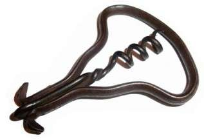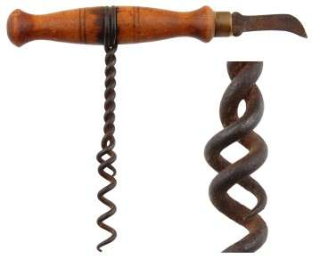12
It is so constructed that after it has been adjusted the engineer has only to keep on
twisting and the cork will be hoisted high and dry
[see
―
Chinnock 1884 Patent
”
below]
.
There are a few rules regarding the use of the corkscrew which are generally observed
by the elite. The place for the corkscrew is not by the side of the hostess's plate.
Champagne bottles are not opened with a corkscrew, nor condensed milk cans, nor
cocoanuts. Any person who has tried to take small cucumber pickles from a bottle with
a corkscrew will ever afterward endeavor to have a pickle fork at hand, if he does not
go to the extreme of having the pickles removed from the original package before they
are brought to the table. It may be set forth as general rule that any attempt to utilize the
corkscrew for any purpose other than the removal of corks will result in
embarrassment, and had best not be tried except in privacy.
Clough 1876 Patent
On February 1, 1876, William Rockwell
Clough was granted U. S. Patent No.
172,868 for his corkscrew with twisted
wire. The example pictured here is a
―
Duplex Power Corkscrew.
‖
Clough's
first claim was
―
A corkscrew formed of a
single piece of wire, a portion of the wire
being formed into a screw, its upper part
formed into a handle, and its free end
utilized to strengthen the shank between
the handle and screw.
Barnes 1884 Patent
Photo courtesy of Josef L'Africain
U. S. Patent No. 299,100 was issued to Joshua Barnes on May 27, 1884. Barnes' fourth
claim was
―
A corkscrew with a folding handle, provided with convex jaws fitting into
corresponding concavities in the shank of the screw-coil, and provided with a hook or
hooks.
‖
The hooks could be used as a wire breaker or as the writer of the 1884 suggests
for opening bottles of milk!

